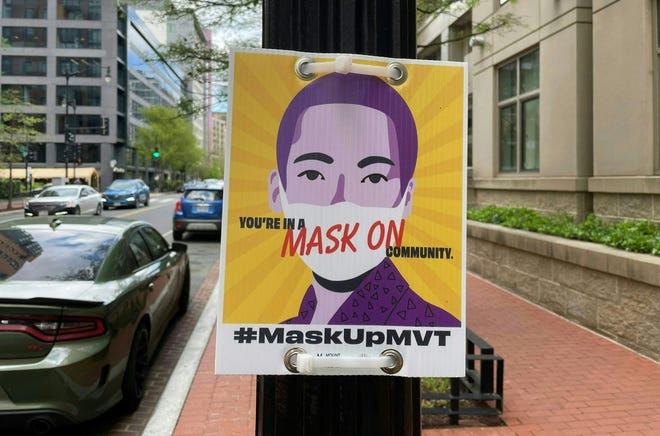The Centers for Disease Control and Prevention announced guideline changes allowing most Americans to unmask indoors, which health experts say may be the first step in shifting the U.S. to an “endemic phase” of the pandemic.
The agency said in a news briefing Friday afternoon it will be using different metrics to determine whether to recommend face coverings.
Under the old guidelines, masks were recommended for people living in communities of substantial or high transmission, which applied to roughly 95% of U.S. counties.
Now, in addition to caseloads, the guidance also will consider hospitalizations, current beds occupied by COVID patients and hospital capacity. The new metrics would put more than half of U.S. counties – where more than 70% of Americans live – in areas of low or medium risk, according to the CDC data.
“We are in a stronger place today as a nation with more tools today to protect ourselves and our community from COVID-19 like vaccination, boosters, broader access to testing, availability of high quality masks, accessibility to new treatments, and improved ventilation,” CDC director Dr. Rochelle Walensky said during Friday’s briefing.
WHAT IS THE CDC MASK GUIDANCE WHERE YOU LIVE? Click here.
Officials say the new guidelines won’t immediately impact federal mask mandates and Americans will still be required to wear face coverings on public transportation until a decision is made closer to March 18, when the mandate is set to expire.
However, the CDC says schools are included in the public settings where masking and testing may not be necessary if the COVID-19 risk is low based on the new metrics.
The CDC advises people who are at higher risk of severe disease from COVID-19 – or those who live with people who are at risk – to take extra precautions, regardless of their own community status.
NO CHANGE FOR TRAVEL:Yes, masks are still required on planes and at airports despite new CDC mask guidelines

Health experts say the move makes sense as the vast majority of vulnerable Americans are fully vaccinated and widespread transmission of the omicron variant has ultimately led to less hospitalizations and death.
The pace of new cases has fallen 36% from a week earlier, and the pace of reported deaths has dropped 22%, Johns Hopkins University data shows. Hospitals have 24% fewer COVID-19 patients than a week earlier, according to Health and Human Services data.
“We had a pretty good understanding of the correlation of cases and hospitalizations and ICU beds and loss of life,” said Dr. Chris Beyrer, professor of epidemiology at Johns Hopkins Bloomberg School of Public Health. “With omicron, that calculation really changed because the virus is so much more transmissible but significantly milder.”
Case numbers and positive tests, alone, no longer capture an accurate picture of COVID-19 risk in the U.S. as many Americans rely on at-home rapid tests and results go unreported, said Jodie Guest, professor and vice chair of the department of epidemiology at Emory University’s Rollins School of Public Health.
“Positivity rates are harder to interpret with so much antigen testing going on. They’re not the whole picture anymore,” she said. Hospitalizations and hospital capacity “present a much clearer picture.”
HOW DOES COVID-19 AFFECT ME?Don’t miss an update with USA TODAY’s free Coronavirus Watch newsletter
‘ACCEPTABLE DISEASE BURDEN’:As COVID-19 cases fall, experts are optimistic, but for how long?
She says it’s a good step for the CDC, but also hopes the metric will include vaccination rates in the future.
The new policy comes as the Biden administration moves to shift its focus to preventing serious illness and death from COVID-19, rather than all instances of infection, as part of a strategy adjustment for a new “phase” in the response as the virus becomes endemic.
Nearly all U.S. states that had put in place indoor mask-wearing mandates for the winter omicron surge are letting them lapse as cases have precipitously dropped nationwide. Some have eliminated the mandates entirely, while others have kept mask-wearing requirements in place for schools and medical facilities.
Some health experts worry the new metrics could lead to a rise in cases and hospitalizations. Others worry masking guidelines may be difficult to reimpose if another variant of concern arrives and appears to evade omicron-generated immunity.
Americans should be ready return to masking if the science changes, health experts say. For now, the data shows the U.S. is on the right track.
“Are we still going to be vigilant? There’s no question about that,” Beyrer said. “But this does look like the beginning of a next phase and let’s hope it lasts.”
Contributing: Karen Weintraub, USA TODAY; The Associated Press. Follow Adrianna Rodriguez on Twitter: @Adrianna USAT.
Health and patient safety coverage at USA TODAY is made possible in part by a grant from the Masimo Foundation for Ethics, Innovation and Competition in Healthcare. The Masimo Foundation does not provide editorial input.
